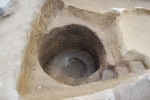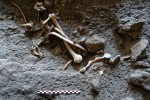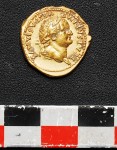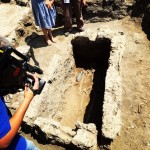 Last year, the international and interdisciplinary archaeological team from the Jean Bérard Center of Naples excavating the Porta Ercolano are outside Pompeii’s northwest gate made headlines when they discovered a rare intact 4th century B.C. Samnite tomb. Now the same team has found another Samnite tomb from the same period, plus the skeletal remains of four people fleeing the eruption of Vesuvius and a few of the treasures they carried with them.
Last year, the international and interdisciplinary archaeological team from the Jean Bérard Center of Naples excavating the Porta Ercolano are outside Pompeii’s northwest gate made headlines when they discovered a rare intact 4th century B.C. Samnite tomb. Now the same team has found another Samnite tomb from the same period, plus the skeletal remains of four people fleeing the eruption of Vesuvius and a few of the treasures they carried with them.
 As is traditional with Roman cities, areas outside the walls were used for tombs and for artisanal workshop, in this case primarily pottery shops, because they’d make a lot of noise, produce smoke, noxious odors, etc. that would be a nuisance in the densely populated city center. In fact, the team has been excavating this area for five years to study the pottery production facilities and the role of crafts in the Pompeiian economy. They didn’t really think they’d find anything new in this particular spot because it had already been excavated in the 19th century by the great Giuseppe Fiorelli, Pompeii’s groundbreaking director of works who devised the plaster cast system to capture the last moments of Vesuvius’ victims.
As is traditional with Roman cities, areas outside the walls were used for tombs and for artisanal workshop, in this case primarily pottery shops, because they’d make a lot of noise, produce smoke, noxious odors, etc. that would be a nuisance in the densely populated city center. In fact, the team has been excavating this area for five years to study the pottery production facilities and the role of crafts in the Pompeiian economy. They didn’t really think they’d find anything new in this particular spot because it had already been excavated in the 19th century by the great Giuseppe Fiorelli, Pompeii’s groundbreaking director of works who devised the plaster cast system to capture the last moments of Vesuvius’ victims.
 Soon after the dig season began on May 16th, the team was delighted to find, in keeping with their mission, the remains of two shops. One had a vertical pit with a staircase built into the side, a unique design never found before in Pompeii. Archaeologists believe it may have been a furnace used to manufacture bronze objects. The second workshop, closer to the city gate, has a circular well dug into the soil that may have been used to extract construction materials. Archaeologists aren’t certain of its purpose. It was accessible by a spiral staircase carved into the terrain. Research will continue over the next month and other shops nearby will be excavated.
Soon after the dig season began on May 16th, the team was delighted to find, in keeping with their mission, the remains of two shops. One had a vertical pit with a staircase built into the side, a unique design never found before in Pompeii. Archaeologists believe it may have been a furnace used to manufacture bronze objects. The second workshop, closer to the city gate, has a circular well dug into the soil that may have been used to extract construction materials. Archaeologists aren’t certain of its purpose. It was accessible by a spiral staircase carved into the terrain. Research will continue over the next month and other shops nearby will be excavated.
 The remains of Vesuvius’ victims were found in the back room of one of the shops. The four appear to be young people, one of them a teenage girl, who made it outside the city gate but must have been compelled to stop and seek shelter, probably in the futile attempt to dodge the pyroclastic flow ringing the death knell for the city. The remains were jumbled up against the wall, the result of looters known as fossores who tunneled through the ash to scavenge any valuables people had taken with them when they tried to outrun the volcano. The exact date of this incursion is hard to establish; sometime between the eruption of 79 A.D. and the official excavations of the 19th century.
The remains of Vesuvius’ victims were found in the back room of one of the shops. The four appear to be young people, one of them a teenage girl, who made it outside the city gate but must have been compelled to stop and seek shelter, probably in the futile attempt to dodge the pyroclastic flow ringing the death knell for the city. The remains were jumbled up against the wall, the result of looters known as fossores who tunneled through the ash to scavenge any valuables people had taken with them when they tried to outrun the volcano. The exact date of this incursion is hard to establish; sometime between the eruption of 79 A.D. and the official excavations of the 19th century.
 The fossores didn’t get everything, though. Three gold coins and a gold foil pendant in the shape of a flower were found amidst the bones. The coins are aurei of the emperor Vespasian dating to 74, 77/78 A.D. There were also some undamaged ceramics: a bowl, three small pitchers, two lids of cooking vessels charred from their quotidian use, not the eruption, and an elegant white urceus, a tall, slender, one-handled vessel used to contain garum, the fermented salted, sun-cured fish intestine sauce that Romans used on everything.
The fossores didn’t get everything, though. Three gold coins and a gold foil pendant in the shape of a flower were found amidst the bones. The coins are aurei of the emperor Vespasian dating to 74, 77/78 A.D. There were also some undamaged ceramics: a bowl, three small pitchers, two lids of cooking vessels charred from their quotidian use, not the eruption, and an elegant white urceus, a tall, slender, one-handled vessel used to contain garum, the fermented salted, sun-cured fish intestine sauce that Romans used on everything.
 Dating to the 4th century B.C., the Samnite tomb is lined with limestone slabs and contains the remains of an adult male with grave goods quite different from those found in the tomb of a woman last year. There are six vases — among them an oinochoe, a lekythos, a kylix, a skyphos and a globular aryballos with a flat bottom — all black painted without any decoration painted over it, unlike last year’s tomb. The tomb is not fully excavated yet, but archaeologists are on the look-out for remains of a belt buckle and/or weapons that have been found before in the graves of Samnite men.
Dating to the 4th century B.C., the Samnite tomb is lined with limestone slabs and contains the remains of an adult male with grave goods quite different from those found in the tomb of a woman last year. There are six vases — among them an oinochoe, a lekythos, a kylix, a skyphos and a globular aryballos with a flat bottom — all black painted without any decoration painted over it, unlike last year’s tomb. The tomb is not fully excavated yet, but archaeologists are on the look-out for remains of a belt buckle and/or weapons that have been found before in the graves of Samnite men.
From the late 5th century, early 4th century B.C., a period of great transition when the Samnite peoples, originally located in the Apennines, spread into the territories of other Italic tribes and Greek colonies finally reaching the Mediterranean. Before the eruption of Vesuvius, Pompeii was less than a third of a mile from the coast, so the Samnite presence there is an important benchmark of the last stages of its expansion. Very little archaeological material has been found from this period, so all discoveries take on even greater significance.